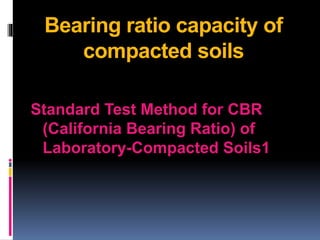
Bearing ratio capacity of compacted soil
- 1. Bearing ratio capacity of compacted soils Standard Test Method for CBR (California Bearing Ratio) of Laboratory-Compacted Soils1
- 2. DEFINITION CALIFORNIA BEARING RATIO IS THE RATIO OF FORCE PER UNIT AREA REQUIRED TO PENETRATE IN TO A SOIL MASS WITH A CIRCULAR PLUNGER OF 50MM DIAMETER AT THE RATE OF 1.25MM / MIN.
- 3. Summary of Test Method 1.For tests performed on materials compacted to one water content, three specimens are prepared.The specimens are compacted using three different compactive efforts to obtain unit weights both above and below the desired unit weight. After allowing specimens to take on water by soaking, or other specified treatment such as curing, each specimen is subjected to penetration by a cylindrical rod. Results of stress (load) versus penetration depth are plotted to determine the CBR for each specimen.The CBR at the specified density is determined from a graph of CBR versus dry unit weight.
- 4. 2. For tests in which the result is to be determined for a water content range, a series of specimens at each of three compactive efforts are prepared over the range of water content of interest. The compactive efforts are chosen to produce unit weights above and below the desired unit weight. After allowing the specimens to take on water by soaking, or other specified treatment such as curing, each specimen is penetrated. Results are plotted to obtain the CBR for each specimen. A plot of CBR versus unit weight for each water content is made to determine the minimum CBR for the water content range of interest.
- 5. Significance and Use This test method is used to evaluate the potential strength of subgrade , subbase , and base course material, including recycled materials for use in road and airfield pavements. The CBR value obtained in this test forms an integral part of several flexible pavement design methods.
- 6. PROCEDURE There are two types of methods in compacting soil specimen in the CBR moulds i. Static Compaction method. ii. Dynamic Compaction method. The material used in the above two methods shall pass 19mm sieve for fine grained soils and 37.50mm sieve for coarse materials up to 37.50mm. Replace the material retained on 19mm sieve by an equal amount of material passing 19mm sieve and retained on 4.75mm sieve Replace the material retained on 37.50mm sieve by an equal amount of material passing 37.50mm sieve and retained on 4.75mm sieve.
- 8. SURCHARGE
- 10. Rammer
- 11. MIXING TOOLS
- 12. Static Compaction 1 In this method calculate the mass of wet soil at required moisture content to give a desired density when compacted in a standard test mould as given below Volume of mould = 2250cc. Weight of dry soil (W) = 2250 x MDD. m Weight of wet soil =1+ m/100xW Weight of water = Weight of wet soil - Weight of dry soil. m = Optimum moisture content obtained from the laboratory compaction test.
- 13. 2.Take oven dried soil sample of calculated weight and thoroughly mix with water (OMC) as obtained from the above equation. 3.Record the empty weight of the mould with base plate, with extension collar removed (m1). 4.Place the correct mass of the wet soil in to the mould in five layers. 5.Gently compact each layer with the spacer disc. 6.Place a filter paper on top of the soil followed by a 5cms displacer disc.
- 14. 7.Compact the mould by pressing it in between the platens of the compression testing machine until the top of the spacer disc comes flush with the top of the mould. 8.Held the load for about 30 seconds and then release. Dynamic Compaction 1.Take representative sample of soil weighing approximately 6kg and mix thoroughly at OMC. 2.Record the empty weight of the mould with base plate, with extension collar removed (m1).
- 15. 3.Replace the extension collar of the mould. 4.Insert a spacer disc over the base plate and place a coarse filter paper on the top of the spacer disc. 5.Place the mould on a solid base such as a concrete floor or plinth and compact the wet soil in to the mould in five layers of approximately equal mass each layer being given 56 blows with 4.90kg hammer equally distributed and dropped from a height of 450 mm above the soil.
- 16. 6.The amount of soil used shall be sufficient to fill the mould, leaving not more than about 6mm to be struck off when the extension collar is removed. 7.Remove the extension collar and carefully level the compacted soil to the top of the mould by means of a straight edge. 8.Remove the spacer disc by inverting the mould and weigh the mould with compacted soil (m2). 9.Place a filter paper between the base plate and the inverted mould. 10.Replace the extension collar of the mould.
- 17. Test for Swelling This test is optional and may be omitted if not necessary. Determine the initial height of specimen (h) in mm. Mount the expansion-measuring device along with the tripod on the edge of the mould and record the initial dial gauge reading (ds). Keep this set up as such undisturbed for 96 hours noting down the readings every day against the time of reading.
- 18. Maintain a constant water level through out the period of soaking. Note the final reading of the dial gauge at the end of soaking period (dh). Calculations for Swelling Expansion ratio=df - ds/h x 100 ds = Initial dial gauge reading in mm df = final dial gauge reading in mm h = initial height of specimen in mm
- 19. Penetration Test After 96 hours of soaking take out the specimen from the water and remove the extension collar, perforated disc, surcharge weights and filter paper.